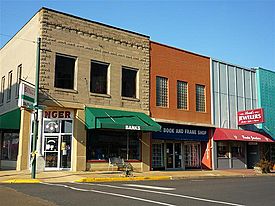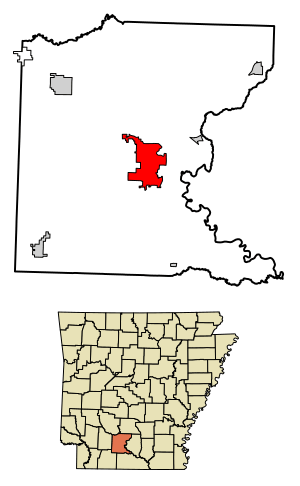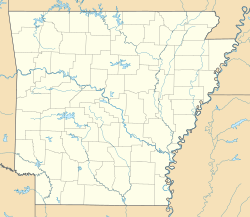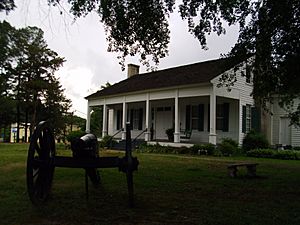Camden, Arkansas facts for kids
Quick facts for kids
Camden, Arkansas
|
||
|---|---|---|
| City of Camden | ||

Downtown Camden
|
||
|
||
| Motto(s):
"Star of the River"
|
||

Location in Ouachita County and the state of Arkansas
|
||
| Country | ||
| State | ||
| County | Ouachita | |
| Township | Ecore Fabre, Lafayette | |
| Incorporated | December 11, 1844 | |
| Government | ||
| • Type | Mayor–Council | |
| Area | ||
| • Total | 16.62 sq mi (43.04 km2) | |
| • Land | 16.53 sq mi (42.80 km2) | |
| • Water | 0.09 sq mi (0.24 km2) | |
| Elevation | 102 ft (31 m) | |
| Population
(2020)
|
||
| • Total | 10,612 | |
| • Density | 642.14/sq mi (247.93/km2) | |
| Time zone | UTC−06:00 (CST) | |
| • Summer (DST) | UTC−05:00 (CDT) | |
| ZIP codes |
71701, 71711
|
|
| Area code(s) | 870 | |
| FIPS code | 05-10720 | |
| GNIS feature ID | 2403976 | |
Camden is a city in Ouachita County, Arkansas. It's located in the south-central part of the state. The city is about 100 miles south of Little Rock. Camden grew up on bluffs overlooking the Ouachita River, which was very important for its development.
The city's recorded history began in 1782. That's when a Spanish military post was set up. This post was on the site of an older French trading spot called Écore à Fabri. When Ouachita County was formed in 1842, American settlers changed the name to Camden. The city became a very important port during the steamboat era. It was known as the "Queen City" of the Ouachita. In 1864, Camden became a key location in the Red River Campaign. This was a major effort during the American Civil War and led to several important battles.
In 2020, Camden had a population of 10,612 people. It is the main city of the Camden Micropolitan Statistical Area. This area includes all of Ouachita and Calhoun counties.
Contents
Camden's Story: A Journey Through Time
Early Explorers and Settlements
In 1673, explorers Father Jacques Marquette and Louis Joliet came to this area. Later, René-Robert Cavelier, Sieur de La Salle arrived in 1682. They claimed the land for France, calling it Louisiana. They found the Quapaw people living near the Arkansas and Mississippi rivers. The Quapaw claimed the land around the Ouachita River. However, the Caddo people also had a strong influence here through trade and culture.
An old Native American path, called the Caddo Trace, crossed the Ouachita River where Camden is today. This path connected Quapaw villages on the Arkansas River to Caddo villages on the Red River. French hunters, trappers, and traders were drawn to the area. They set up a meeting spot on the high bluff above the river crossing. This place became known as Ecore a Fabri, or Fabri's Bluff.
In 1762, France gave Louisiana to Spain. In 1782, the Spanish governor sent Jean Baptiste Filhiol to set up a military post. Filhiol first chose Ecore a Fabri. He hoped to create a settlement there. After about two years, he moved downriver to a more central spot. This place is now Monroe, Louisiana.
Growing into a City
By 1819, early settlers like Jesse Bowman and the Tate brothers arrived. In 1824, John Nunn became one of the first permanent settlers at Ecore a Fabri. Steamboats began arriving in the 1820s. This connected Ecore a Fabri directly to markets in New Orleans. Because it was at the end of where steamboats could easily travel, Ecore a Fabri became a busy trading center.
In 1842, Ouachita County was formed. Ecore a Fabri was chosen as the county seat. Its name was changed to Camden. This was suggested by Thomas Woodward, one of the commissioners.
Camden quickly became the second-largest city in Arkansas. It was a busy river port with many steamboats. These boats carried people and goods, mostly between Camden and New Orleans. Camden was also the main office for John T. Chidester's stagecoach line. This company carried mail for the Butterfield stage line from Memphis to Fort Smith.
The Civil War Era
During the American Civil War, Camden was important in the Red River Campaign of 1864. U.S. Army General Frederick Steele moved south from Little Rock. He planned to go to Shreveport, Louisiana. But he only reached Camden, which his troops occupied. The Confederates moved back to defend Washington, Arkansas.
To protect Camden, forts like Lookout and Southerland were built in 1864. The Camden Water Battery was also built later that year. After losing battles at Poison Spring and Marks’ Mill, Steele had to retreat. Camden and south Arkansas remained under Confederate control until the war ended.
From the 1900s to Today
Before steamboats became less common, Camden became a railroad town. It was served by the St. Louis Southwestern Railway and other lines. The town remained an important place for shipping cotton. In the 1920s, the discovery of oil in South Arkansas brought a lot of growth to the economy.
In 1927, the International Paper Company built a paper mill in Camden. This followed the growth of the lumber industry in south Arkansas. For many years, Camden was the headquarters for the Clyde E. Palmer newspaper chain. This included The Camden News.
During World War II, Camden had one of Arkansas's training fields for pilots. This base was called Harrell Field. It was later given to the US Navy in 1944 and became the Shumaker Naval Ammunition Depot. This created thousands of new jobs. The Korean War also brought more activity to the depot.
After the Korean War, the depot closed. The city and county turned its facilities into a large industrial area. This area became home to major defense companies and other smaller businesses. A campus of Southern Arkansas University, called Southern Arkansas University Tech, is also located there.
In the 1990s, after the Cold War, many defense jobs were lost. This caused a decline in Camden's population. The International Paper Company mill also closed, leading to more job losses. However, in recent years, defense contracts have partly returned. Also, new small businesses have helped stabilize the town's economy.
Camden was the home of Buckshot Smith (1929-2024). He was America's oldest active police officer from 2020 until he retired in 2023.
Geography and Climate
Camden is located on the Ouachita River. It's at the point where the river becomes difficult to navigate by boat. The city covers about 16.5 square miles (43.04 square kilometers). Most of this area is land, with a small amount of water.
Weather in Camden
The climate in Camden has hot summers and cool winters. It's known as a humid subtropical climate. This means it gets a lot of rain throughout the year.
| Climate data for Camden, Arkansas (1991–2020 normals, extremes 1890–present) | |||||||||||||
|---|---|---|---|---|---|---|---|---|---|---|---|---|---|
| Month | Jan | Feb | Mar | Apr | May | Jun | Jul | Aug | Sep | Oct | Nov | Dec | Year |
| Record high °F (°C) | 86 (30) |
89 (32) |
93 (34) |
95 (35) |
99 (37) |
107 (42) |
111 (44) |
115 (46) |
109 (43) |
102 (39) |
90 (32) |
88 (31) |
115 (46) |
| Mean maximum °F (°C) | 73.7 (23.2) |
77.1 (25.1) |
83.8 (28.8) |
87.3 (30.7) |
91.2 (32.9) |
96.4 (35.8) |
99.9 (37.7) |
100.0 (37.8) |
96.2 (35.7) |
90.2 (32.3) |
81.5 (27.5) |
74.8 (23.8) |
101.7 (38.7) |
| Mean daily maximum °F (°C) | 53.3 (11.8) |
57.9 (14.4) |
66.4 (19.1) |
74.5 (23.6) |
81.4 (27.4) |
88.8 (31.6) |
91.9 (33.3) |
92.0 (33.3) |
86.0 (30.0) |
75.7 (24.3) |
64.0 (17.8) |
55.6 (13.1) |
74.0 (23.3) |
| Daily mean °F (°C) | 42.3 (5.7) |
46.1 (7.8) |
54.1 (12.3) |
62.0 (16.7) |
70.4 (21.3) |
78.1 (25.6) |
81.5 (27.5) |
80.8 (27.1) |
74.2 (23.4) |
62.9 (17.2) |
52.0 (11.1) |
44.4 (6.9) |
62.4 (16.9) |
| Mean daily minimum °F (°C) | 31.2 (−0.4) |
34.2 (1.2) |
41.8 (5.4) |
49.6 (9.8) |
59.5 (15.3) |
67.4 (19.7) |
71.1 (21.7) |
69.7 (20.9) |
62.4 (16.9) |
50.1 (10.1) |
40.0 (4.4) |
33.3 (0.7) |
50.9 (10.5) |
| Mean minimum °F (°C) | 17.4 (−8.1) |
22.0 (−5.6) |
26.5 (−3.1) |
35.0 (1.7) |
46.1 (7.8) |
58.0 (14.4) |
64.6 (18.1) |
62.1 (16.7) |
48.3 (9.1) |
35.3 (1.8) |
25.6 (−3.6) |
21.0 (−6.1) |
15.4 (−9.2) |
| Record low °F (°C) | −10 (−23) |
−10 (−23) |
12 (−11) |
26 (−3) |
35 (2) |
44 (7) |
51 (11) |
48 (9) |
33 (1) |
20 (−7) |
12 (−11) |
1 (−17) |
−10 (−23) |
| Average precipitation inches (mm) | 4.33 (110) |
4.67 (119) |
5.43 (138) |
5.36 (136) |
4.55 (116) |
3.52 (89) |
4.11 (104) |
3.18 (81) |
3.53 (90) |
4.80 (122) |
4.17 (106) |
5.47 (139) |
53.12 (1,349) |
| Average snowfall inches (cm) | 0.9 (2.3) |
0.3 (0.76) |
0.3 (0.76) |
0.0 (0.0) |
0.0 (0.0) |
0.0 (0.0) |
0.0 (0.0) |
0.0 (0.0) |
0.0 (0.0) |
0.0 (0.0) |
0.0 (0.0) |
0.0 (0.0) |
1.5 (3.8) |
| Average precipitation days (≥ 0.01 in) | 9.4 | 8.5 | 9.1 | 7.8 | 8.7 | 7.3 | 7.2 | 6.1 | 5.7 | 7.0 | 7.7 | 8.8 | 93.3 |
| Average snowy days (≥ 0.1 in) | 0.3 | 0.2 | 0.1 | 0.0 | 0.0 | 0.0 | 0.0 | 0.0 | 0.0 | 0.0 | 0.1 | 0.0 | 0.7 |
| Source: NOAA | |||||||||||||
People of Camden
| Historical population | |||
|---|---|---|---|
| Census | Pop. | %± | |
| 1850 | 894 | — | |
| 1860 | 2,219 | 148.2% | |
| 1870 | 1,612 | −27.4% | |
| 1880 | 1,503 | −6.8% | |
| 1890 | 2,571 | 71.1% | |
| 1900 | 2,840 | 10.5% | |
| 1910 | 3,995 | 40.7% | |
| 1920 | 3,238 | −18.9% | |
| 1930 | 7,273 | 124.6% | |
| 1940 | 8,975 | 23.4% | |
| 1950 | 11,372 | 26.7% | |
| 1960 | 15,823 | 39.1% | |
| 1970 | 15,147 | −4.3% | |
| 1980 | 15,356 | 1.4% | |
| 1990 | 14,380 | −6.4% | |
| 2000 | 13,154 | −8.5% | |
| 2010 | 12,183 | −7.4% | |
| 2020 | 10,612 | −12.9% | |
| U.S. Decennial Census | |||
As of the 2020 United States census, Camden had 10,612 people. There were 4,221 households and 2,523 families living in the city.
Who Lives in Camden?
In 2020, the people living in Camden were mostly:
- About 56% Black or African American
- About 36.3% White
- About 4.2% Mixed race (people of two or more races)
- About 2.4% Hispanic or Latino (who can be of any race)
- Smaller percentages of Asian, Native American, and Pacific Islander people.
Things to See and Do
Exploring Camden's History
One interesting place to visit is the McCollum-Chidester House. It's home to the Ouachita County Historical Society. Peter McCollum, a local merchant, built the house in 1847. Later, John T. Chidester bought it in 1857. He used it as a stop on his stagecoach line. This house was even shown in the TV series North and South.
Camden has many historic buildings. There are two areas listed on the National Register of Historic Places. These are the Clifton and Greening Streets Historic District and the Washington Street Historic District. The old Camden Post Office, built in 1895, is also on the register. It's now a popular restaurant. The White House Cafe, opened in 1907, is the oldest restaurant in Arkansas that's still running!
Learning in Camden
Public education is available for students from early childhood through high school. This is provided by two main school districts:
- Camden Fairview School District, which includes Camden Fairview High School.
- Harmony Grove School District, which includes Harmony Grove High School.
Before 1970, African American students attended Lincoln High School. It closed after the Brown v. Board of Education ruling ended school segregation.
Famous People from Camden
Many notable people have connections to Camden, including:
- Shawn Andrews (born 1982); played football for the Philadelphia Eagles and NY Giants.
- Stacy Andrews (born 1981); played football for the Cincinnati Bengals and other NFL teams.
- Jonathan Davis (born 1992); played baseball in the minor leagues and for the Toronto Blue Jays.
- Betty Jo Dobbs (1930–1994); a historian who studied Isaac Newton.
- Alexander Hawthorn (1825–1899); a lawyer, minister, and Confederate general.
- George Hays (1863–1927); the 24th governor of Arkansas.
- James Hildreth (born 1956); President and CEO of Meharry Medical College.
- Benjamin Laney (1896–1977); the 33rd governor of Arkansas.
- Ne-Yo (born 1979 as Shaffer Chimere Smith); a famous R&B singer, songwriter, and producer.
- Andre Patterson (born 1960); an NFL line coach.
- David Pryor (born 1934); a U.S. Representative, governor of Arkansas, and U.S. Senator.
- Tony Tillman (born 1981 as Tony Daniel Frazier); a Christian hip hop artist.
- Tommy Tuberville (born 1954); a U.S. senator from Alabama.
- David Warner Hagen (1931–2022); a United States District Court judge.
- Edward A. Warren (1818–1875); a politician who represented Ouachita County.
- Gertrude Weaver (1898–2015); once declared the oldest living documented person.
- Corey Williams (born 1980); played football for the Green Bay Packers and other NFL teams.
Images for kids
See also
 In Spanish: Camden (Arkansas) para niños
In Spanish: Camden (Arkansas) para niños








